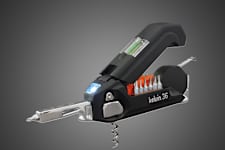From becoming the first female founder of a space company to go public to placing a "constellation" in the sky, this "astropreneur" isn't done yet.
By Adriana Navarro, AccuWeather staff writer
Published Sep. 2, 2022 4:40 PM EDT | Updated Sep. 5, 2022 9:45 AM EDT
By 2026, there could be a new constellation in the night sky, and Carol Craig is hoping to be the one to place it there.
AccuWeather National Reporter Jillian Angeline spoke with Craig, the CEO and Founder of the Aerospace and defense company Sidus Space, to discuss her ambitious goals, which involve launching 100 satellites into low Earth orbit by 2026. The grouping of satellites, known as a constellation, has been dubbed LizzieSat and will make weather and other data more accessible.
Weighing in at about 220 pounds (100 kilograms), each satellite is about the size of a coffee table -- fairly larger than a CubeSat, a nanosatellite roughly double the size of a Rubik's cube -- and is commonly used in low Earth orbit, allowing it more functionality and space for more sensors to capture data.
There's a chance that stargazers won't easily see this constellation, however. In terms of reflectivity, spokesperson Madison Buiting told AccuWeather that compared to other satellite constellations, the impact is minimal.
Following the first launch of SpaceX's Starlink constellation in 2019, astronomers have raised concerns about satellite constellations washing out parts of the night sky. SpaceX has since planned on treating the Starlink satellites with a special coating to reduce brightness, but they are still visible to some observers. As of July 2022, the company had launched some 2,900 satellites, according to SPACE.com.

"'Bringing space down to Earth'," Craig said, echoing the company's tagline. "It shouldn't be mysterious. We should be able to benefit from that data."
The 3D printed satellites will have a variety of different jobs which could include forecasting, hurricane tracking and monitoring soil content.
"There are a number of sensors here on Earth used to predict weather and data. Those same kinds of sensors can be tested to be applicable to satellites. And they can provide in near real-time, can be more accurate [and] can be less expensive," Craig said.
The "astropreneur" and first female founder of a space company that has gone public also played a role in NASA's Artemis I moon rocket, helping to produce hardware from ground systems to reinforcements of the actual facilities to the rocket.
"When you think about protecting our environment and protecting our Earth, to be able to extend to the moon, and not replacing Earth, but protecting it a little more," Craig said. "There's going to be more things we can do off the moon, and then Mars, that will allow us to preserve the Earth."
More to read:
Want next-level safety, ad-free? Unlock advanced, hyperlocal severe weather alerts when you subscribe to Premium+ on the AccuWeather app.AccuWeather Alerts™ are prompted by our expert meteorologists who monitor and analyze dangerous weather risks 24/7 to keep you and your family safer.







No comments:
Post a Comment